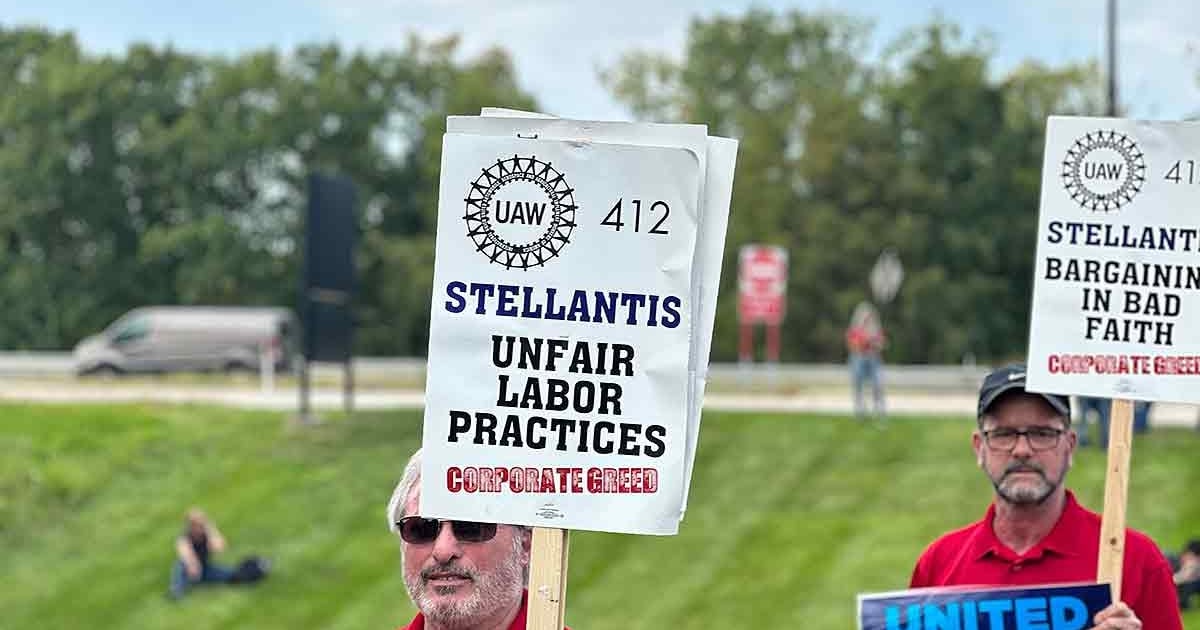
Stellantis on Wednesday said it had submitted a new contract proposal to the UAW, while General Motors sought to counter what it called “misinformation” by sharing more financial details of its latest offer.
Stellantis presented its latest offer on Tuesday, according to a spokesperson. The company said the proposal — its fifth since negotiations began — “focused on subcommittee open issues,” but gave no further details.
A UAW source on Wednesday confirmed that the union had received a new offer from Stellantis. It’s the first new offer from any of the three automakers since the UAW went on strike against them Friday, Sept. 15, the source said.
Talks were continuing between the UAW and all three companies ahead of the union’s Friday deadline to show “serious progress” toward new contracts. Absent that, UAW President Shawn Fain has said he plans to have workers at more plants join the strike.
A source with knowledge of the negotiations said GM and the union remained far apart on an agreement as of Wednesday. The UAW declined to comment on whether it was close to a deal with any of the three companies.
GM officials went public with specifics about its most recent offer, which includes raises totaling 20 percent over the next four years for UAW-represented employees. That would bring top wages to $39.24 in 2027, including for workers at components and parts distribution facilities who currently earn less than other employees, GM President Mark Reuss said Wednesday.
In an opinion piece published in the Detroit Free Press, Reuss said GM’s Sept. 14 proposal — presented on the day the automaker’s previous contract with the UAW expired — would move all employees covered under the national contract to the same pay system and allow new employees to reach the top wage in four years. That would be a reduction from the current eight years for new hires.
“We have assembly and manufacturing jobs, we have warehousing jobs and we have supply jobs,” Reuss wrote. “Within these distinctly different businesses in our national contract, everyone is paid on the same wage structure.”
GM’s proposal would raise base wages for 85 percent of its represented work force to about $82,000 per year, with total compensation topping $150,000 annually when factoring in overtime pay and benefits such as health care, he wrote. The company’s offer also ensures that products will be allocated to — meaning work would continue at — all of GM’s U.S. facilities, Reuss wrote, signaling that the automaker does not intend to close any plants as it transitions to an all-electric vehicle lineup.
Reuss called the union’s demands “untenable,” noting that GM invests its profits into the company and its employees, including to prepare plants to build EVs and also for future gasoline-powered pickups and SUVs.
GM earned roughly $65 billion in net income from 2013 to 2022, including $9.9 billion last year, according to Reuss’ op-ed piece and GM’s annual reports filed with federal regulators. The automaker’s capital expenditures totaled more than $77 billion in that same period, according to regulatory filings. The company said when reporting second-quarter earnings in July that it expects capital spending of $11 billion to $12 billion this year.
The Detroit 3 have pushed back against the UAW’s criticism of their proposals in recent days. Fain has said the companies are earning record profits but paying “poverty wages” to employees.
“Amid the rhetoric of the United Auto Workers leadership, the flow of misinformation is not fair to anyone. It can be hugely counterproductive to reaching an agreement that gets the GM team back to work quickly, which should be everyone’s goal,” Reuss wrote.
“The record offer we proposed on Sept. 14 recognizes the many contributions our represented team members make to our company — past, present and future,” he wrote. “And it addresses, directly, what they’ve told us matters most: wage growth, job security and long-term stability.”